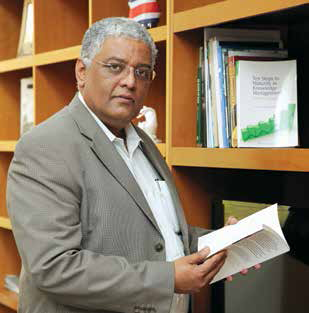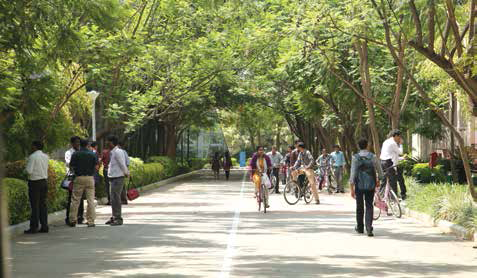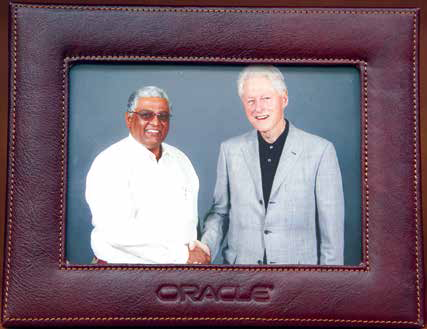Issue No.10 / June 16,2015

Binod Hampapur rangadoreis Executive Vice President and Global Head of Talent and Technology Operations of Infosys Ltd. Based in Bengaluru, his responsibilities comprise Recruitment, Education, Training and Assessment, Talent Planning and Global Immigration, Information Systems, Information Security Group and Commercial and several others. He has over 30 years of industry experience and has held several leadership positions at Infosys. He joined the company in 1993 as the Head of Manpower Planning. Binod HR took on the role of the Global Head of Commercial and Corporate Relations functions in 2010. As a responsible corporate citizen, Binod has funded the establishment of a 150-bed hospital for Sri Sringeri Mutt. In an honorary role, he is the Chairman of the Board of Governors at Rangadore Memorial Hospital, which is named after his father, the late H.S. Rangadore.Corporate Citizen spoke to him about his enriching career and life for young engineers at Infosys
I joined Infosys in 1993 but not before several rounds of discussion with the then boss N S Raghavan and followed by a psychometric test. Curious, I asked him whether he found me mad, but he said the kind of job I was getting into was manpower planning which would result in a lot of conflict on a daily basis and hence the need for psychological analysis. After the test was over, I asked the HR manager to share with me the outcome and how he perceived me. He said I had a tendency to take things to heart, which was true. My boss told me to change and moderate that a little.

When I asked the HR person, as to how I would fit into this role, he told me that since I was earlier in sales, I would have a sales mindset, so I was required to be a bridge between sales and delivery. So, I would have to call the sales folk on a daily basis to get an understanding of our clients’ requirements. Then I would go and find the right kind of person and marry the two. Because it is a movement of people here and not material, it was termed as Manpower Planning. So, it is equal to a Production Planning and Control function (PPC), in engineering company parlance. It was very interesting, but then they realised we were treating people like machines. We were not taking care of people’s aspirations. So then we had to change that model a little, where we distributedhe 1200 odd people to three different units and put them under their respective managers. By virtue of this though, I became jobless.

‘All of that land acquisition happened because of the Infosys tag. Every govt knew that Infosys was a company driven by values and they would not take them for a ride. They knew we would not amass the land to use it for some other purpose.’
When I came back, the manpower department was in a mess at all the three locations. Promptly, I was handed back Manpower Planning. So again I dealt with the strategy as to how it had to be distributed, and built systems using some in-house resources and then again distributed the manpower functions. This streamlined the department so I became jobless again. So I told my boss, if it was difficult for him to ask me to leave, I would myself look for a job and go. But then, immediately, the founders grouped together and in less than half hour, they gave me six options. Mr Murthy withdrew my choice of going back to Pune as I said I would not be able to shift my family. Then Nandan Nilekani assigned me to the banking division of Infosys. At that time we used to have the so called “Banks 2000” software division, which is now famously known by the name `Finacle’ -- 85 percent of India’s banking transactions happen on this platform, created by Infosys. I was in charge of handling customer support and headed the implementation group which implemented this banking software at various banks.

Today, I take care of about 11 functions. Basically I head the talent fulfillment function, it’s called TAFF, it is about recruitment, education, training and assessment, global immigration, and talent planning and deployment. Apart from that, I head Technology Operations, where the CIO of the Communications department and the Information Systems department reports in to me. It also includes heading the Information Security and Purchase group. I am at the helm of India Business. I also handle the Computer and Communication Division. Along with this I do some work for the Infosys Foundation. There is one initiative called Value Global Delivery Model or VGDM which is also done by me. So all of these put together comprise my daily job.
‘Infosys (then) was not a very well known company. Over a period of time people started recognising Infosys, as it became the darling of the stock market. At that point of time young minds wanted to be associated with Infosys.’
‘Basically I used to make teams and break them -- allocate people to various projects, depending on their skill and the new requirements. At that time there were around1200 people.’
During our land acquisition process in Pune, I was shown a barren piece of land in Hinjewadi. I was surprised it was meant for the cultivation of sugarcane, when no plant would grow on such a rocky piece of land. The Maharashtra Industrial Development Corporation (MIDC) had identified that land to set up a tech park. Since we were their anchor client, the CEO of MIDC would receive us at the airport, drive us to a star hotel for lunch before taking us to various land sites.

I insisted with the MIDC that they build a bridge across the national highway, which would be a useful link for software engineers as well as the local farmers. Then the MIDC Deputy CEO went to Delhi and got approval for the bridge within two days. The plan was to build the bridge and also widen the 12 kilometre stretch from Pune University (now Savitribai Phule Pune University) circle all the way to Hinjewadi. When the plan was announced during a meeting at the Pune District Collector ‘s office, the engineers present there started giving reasons why the project could not be done. They said that 8.2 kilometres of the stretch was within Pune Municipal Corporation jurisdiction, 4.26 kms within Pimpri Chinchwad Municipal Corporation jurisdiction, and some parts under other jurisdictions.
I asked the MIDC officials if I was called all the way from Bangalore to be told why the bridge could not be done. I insisted on being told when the bridge would be ready, as the link was necessary for the IT Park and the industry it was serving. Capitalising on my proposition, the MIDC CEO asked if anybody had a problem if the MIDC built the road, at which everyone backed off. So immediately the MIDC took over and finished the road work within the next nine months.
On the day of the Bhoomi Pooja, Mr Murthy fixed the date for the inauguration. This brought pressure on the system to build the initial buildings on the 25 acres land within 10 months.
It was a wonderful experience for the Infosys people who were working at breakneck speed, to interface with government officers who had a positive mind-set.
After the success of the Pune project, for the next project in Sholinganallur, Chennai, Mr Murthy gave us a deadline of only seven months. It was tough to get the 20 acres of land from the government but our patience paid. Luckily the land was not rocky and we were able to complete it very much on time.
I have had very interesting sessions with Chief Ministers of various states during the land acquisition processes. Once in Jaipur, they showed me three land sites and brought me back to the Rajasthan chief minister, who asked me if I liked any of them. I asked if the CM wanted a political answer or an honest answer. The CM said honest answer, and I said none of them. This upset the CM and ordered the industry secretary to put me in a helicopter and fly me over Jaipur for an aerial view. Whichever land I proposed, the CM promised to see how fast it could be done.
All of that land acquisition happened because of the Infosys tag. Every government knew that Infosys was a company with the philosophy of `Powered by Intellect, Driven by Values’ and they would not take them for a ride. They knew our honesty and that we would not amass the land to use it for some other purpose. All of them had faith in Infosys and that was its power. The land acquisition was done at breakneck speed and we were pioneers in whatever we did.
Once, the then Andhra Pradesh government had immediately invited us and offered us 1000 acres of land to move Infosys headquarters to Hyderabad. I had to say no to move the headquarters like that. We finally negotiated 500 acres of land in Hyderabad close to the airport, but had got into some litigation. The chief minister stepped in and told us to identify some other land and promised to get it done. Luckily we identified land in Pocharam.
The only government that did not trust us was the West Bengal government. We bought a piece of land, we paid for that land, but after that they told us they would not give us the Special Economic Zone (SEZ) status. I can’t blame them for their doing that, because one of the election manifestos on which the state government came into power was that it would not encourage SEZs, and not encourage land acquisition for SEZ.
‘There is no short cut in life. One has to work very hard and not worry about the rewards or awards, and success will come automatically to them.’
Around 1993-94 Infosys was not a very well known company. People would join us without knowing what Infosys was. Over a period of time after 1995-96, people started recognising Infosys, as it became the darling of the stock market. At that point of time young minds wanted to be associated with Infosys. Mr Murthy’s theme of `Powered by Intellect, Driven by Values’ was very well accepted and understood by youngsters. Also, Infosys used to be a big employer of people. We were recruiting 20,000 to 30,000 people.
Somewhere along the line the sheen was lost and after that we had to strive a little to make people join us. Till then salary was not a differentiator, the Infosys brand itself was a differentiator. Then we had to start paying slightly higher to attract people. There were a lot of companies doing the same kind of work and paying higher than us. So they started attracting a lot of youngsters.
I have been here for 23 years now and I feel a part of this company. However, today’s generation moves with the trend of changing jobs at the drop of the hat. They believe in working for a couple of years and then begin looking out for an opening in another company. It is slowly resembling the western economy. In Infosys, we have created space and a conducive environment to work in. They initially say `wow, fantastic’ about the campus but slowly realise they have to deliver. When the challenges seem arduous for the youngsters, many a time they try to change the job rather than changing their mindset.
Today, everybody has a smartphone with access to information and so they are very informed. Younger people today are probably a little more firebrand. They don’t take things for granted, I mean they don’t assume it has to be this way. They want to know why this way, why not that way. So that is the difference.
At Infosys, all the people who are recruited other than HR, Finance and some specific functions, are engineers who come from all branches of engineering. As long as they secure 65-70 percent in their academic career and pass our test they are part of our family.
Our business is providing business solutions using technology, so we need the engineering skill. Then we transform that person in about 17 weeks to a software engineer at our foundation training programme at Mysore (now Mysuru). Once they are done with that, they get into projects and start working on planned projects.
Advice for youngsters is that there is no short cut in life. One has to work very hard and not worry about the rewards or awards, and success will come automatically to them. Today’s younger generation looks at quick fixes. It is OK you have had a school dropout who went on to become the chief of Microsoft or a big entrepreneur but those are rare stories. Otherwise, most of us have to work hard to make sure we add value. Actually when you work hard, you only become better and once you become better, people will start recognising you, otherwise they will not.
Today the kind of IT work that is done by various companies is very similar in nature. If this continues, it is only going to be difficult for all these companies. Probably, automation is going to be the future. So you will be relevant if you have this culture of learning and automation in you.
If you look at the demography of people in the world, the only people with a pair of hands that can work in western countries with zero population growth or negative population growth, would only be Indians and Chinese. Of these two, Indians have the added advantage of knowing English. Any person in India speaks three languages - English, Hindi and their mother tongue, so it is not difficult for that person to pick up one or two more foreign languages.
One is to leave this world a better place than we came into. Second is, life is short, make it sweet and always be happy. Bring happiness to others too.
By vinita deshmukh